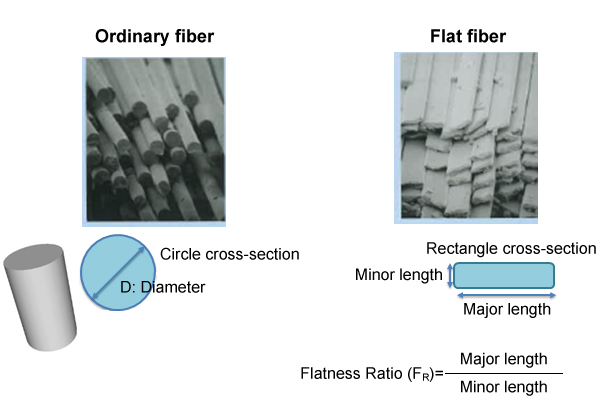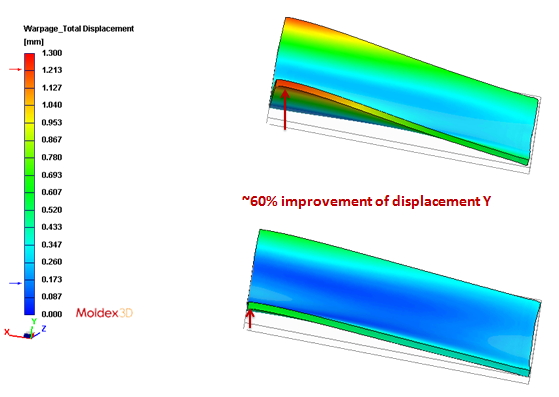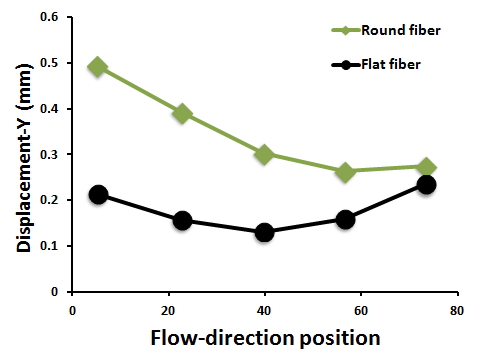Fiber-reinforced thermoplastic (FRT) composites have been widely used in the automotive industry to enhance mechanical properties and reduce warpage deformation. Fibers are usually processed into the form of rods with round cross-sectional shapes. Flat fibers have been recently developed by Nitto Boseki (NITTOBO) Co., Ltd. in Japan [1], which is a Tokyo-based company specializing in textile and fiberglass products. Basically, the cross-sectional shape of a flat fiber is close to a rectangle. To calculate the flatness ratio (FR), divide the length to the width (Fig. 1).

Fig. 1 Ordinary fibers and flat fibers.
The patent and report published by Nitto Boseki (NITTOBO) [1] indicated that the warpage displacement of a flat-fiber filled thermoplastic plate (width = 7µm , length = 28µm , FR = 4) has been reduced by 80% comparing to ordinary fibers [2].
However, very little research has focused on flat fibers, and the technology was not there to simulate and validate flat fibers. To address this issue, the latest version of Moldex3D plastics molding simulation software, R17, has developed new capabilities to predict and validate flat fiber injection molded parts. This can help designers and engineers achieve better mechanical properties and improved dimensional stability. We will compare two warpage displacement results between round fibers and flat fibers (50wt% glass fiber/PP composites) in the following case. For the round fiber, the fiber length LF is 0.3 mm, the fiber diameter is 15µm , and the aspect ratio is 20. For the flat fiber, the fiber length LF is 0.5 mm, the flat ratio FR = 4, the minor length Lmin= 7µm , and the major length Lmax = 28µm .
Fig. 2 shows that flat fibers can effectively reduce the Y-displacement by 60%. Moreover, Fig. 3 indicates that the Y-direction (the part thickness direction) displacement along the X-axis flow length for flat fiber is obviously smaller than round fiber with an improving percentage of about 60%. Moldex3D Fiber analysis results have demonstrated that flat fibers can provide better dimensional stability compared with round fibers. It is expected that the utilization of flat fibers in various applications will continue to grow [3].

Fig. 2 Comparison of the warpage results of round fibers (upper) and flat fibers (lower).

Fig. 3 Comparison of Y-axis displacement of round fibers and flat fibers.
Reference Source:
[1] Nitto Boseki (NITTOBO) Co., Ltd. in Japan https://www.nittobo.co.jp/business/glassfiber/frtp/hisff.htm [2] Flat glass fiber developed for reinforcement of thermoplastic resins https://www.plasticstoday.com/materials/flat-glass-fiber-developed-reinforcement-thermoplastic-resins/96856545057602 [3] Novel ‘Flat’ Fiberglass Enhances Injection Molded TP Composites https://www.ptonline.com/articles/novel-flat-fiberglass-enhances-injection-molded-tp-composites |
Dr. Huan-Chang (Ivor) Tseng
|